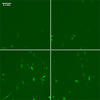The Cell Systems Science Group contributes to the new post-genomic era with research in measurements and models that support the understanding of complex biological phenomena at the cellular and subcellular levels. The group focuses on the cell as a system and tools that can make measurements and characterize the system properties. This is achieved through bioimaging and other cytometry techniques, measurements that assess protein and gene function within living cells, experimental design, and bioinformatics. We are focusing our efforts on measurements for assessing the process of creation, maintenance and differentiation of pluripotent stem cells in addition to cell lines and engineered cells to understand cellular dynamics. The group emphasizes new measurement tool development and protocols that ensure reliability and comparability of cell assay and imaging-based measurements and appropriate data analysis and data handling pipelines. These efforts assist basic biomedical research, biomanufacturing of regenerative medicine products, non-animal toxicology testing, drug development and testing, precision medicine, and other applications that depend on understanding and predicting complex cellular activities.
NEW PROJECTS
A flexible and comprehensive tool dramatically increasing the discoverability of COVID-19 Open Research Dataset (CORD-19)
- Machine Learning/Artificial Intelligence, data curation and discovery tool patented by NIST (MML and ITL) is used to create a database of the COVID-19 Open Research Dataset (CORD-19), a collection of nearly a million scholarly research articles about coronaviruses, SARS-CoV-2 and COVID-19. Visit: https://randr19.nist.gov/
Improving Metrics for Cell-Based Therapies and Regenerative Medicines
Prototype Cell Assay Measurement Platform (P-CAMP)
ALSO, CHECK OUT OUR BLOG DETAILING OUR EVOLVING CAPABILITIES: DEVELOPMENT OF THE NIST PROTOTYPE ADVANCED BIOMETROLOGY LABORATORY
Gene Delivery Systems— through viral and non-viral vector means provide gene therapies mechanisms to deliver genes of interest into a patient’s cells and cure previously untreatable diseases. There is a need for characterization and quality measurements of gene delivery system particles. We are developing methods to measure particle heterogeneity and provide advanced characterization of particle physical and infectious titers.
Fluorescence Microscope Benchmarking—We have made available a method to characterize a fluorescence microscope's performance by benchmarking the detection threshold, saturation and linear dynamic range to a physical artifact (i.e. a …
Assessing NP EHS—Due to their small size, nanoparticles can enter living organisms in previously unforeseen ways and their immense surface area results in higher reactivity compared to corresponding bulk materials. …
Cell-based Immunofluorescence Assays—Microscopy images of cells are often used in cell biology to qualitatively identify features of interest and to discern differences between treatments. Images are also sometimes used to quantify …
Surface Plasmon Resonance Imaging of Cells and Extracellular Matrix Proteins—A critical challenge in cell biology is imaging and quantifying the interactions of cells with their extracellular matrix (ECM) environment, and the active remodeling by cells of their ECM. …
A novel root and rule-based natural language processing (NLP) approach to information indexing and searching—Whether at the level of the individual, team, project or program, research and engineering work must keep abreast of huge amounts of published information that might contain discoveries....
- A novel measure and significance testing in data analysis of cell image segmentation
- Toward Achieving Harmonization in a Nano-cytotoxicity Assay Measurement through an Interlaboratory Comparison Study
- Surface plasmon resonance microscopy: achieving a quantitative optical response
- Strategies for Achieving Measurement Assurance for Cell Therapy Products
- Large-scale Time-lapse Microscopy of Oct4 Expression in Human Embryonic Stem Cell Colonies
- Performance Benchmarking and Intensity Calibration of a Widefield Fluorescence Microscope Using Fluorescent Glas
Contacts
Group Leader
-
(301) 975-8551
Office Manager
-
(301) 975-5317
Staff
-
(301) 975-5512
-
(301) 975-3092
-
(301) 975-5448
-
(301) 975-8022
-
(301) 975-4195
-
(301) 975-2618
-
(301) 975-8022
-
(301) 975-2517
-
(301) 975-8022
-
(301) 975-8142
-
(301) 975-5665
-
(301) 975-5056
-
(301) 975-8524
Associates
-
(301) 975-2211
-
(301) 975-8022







